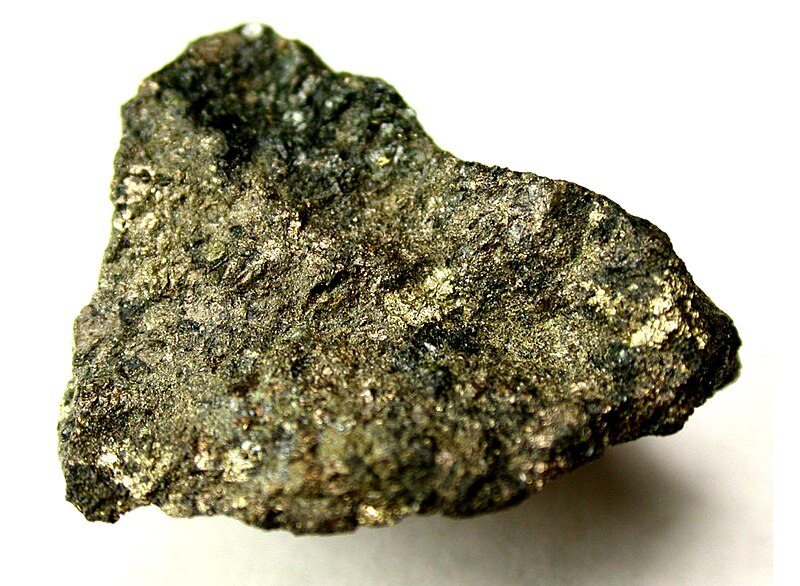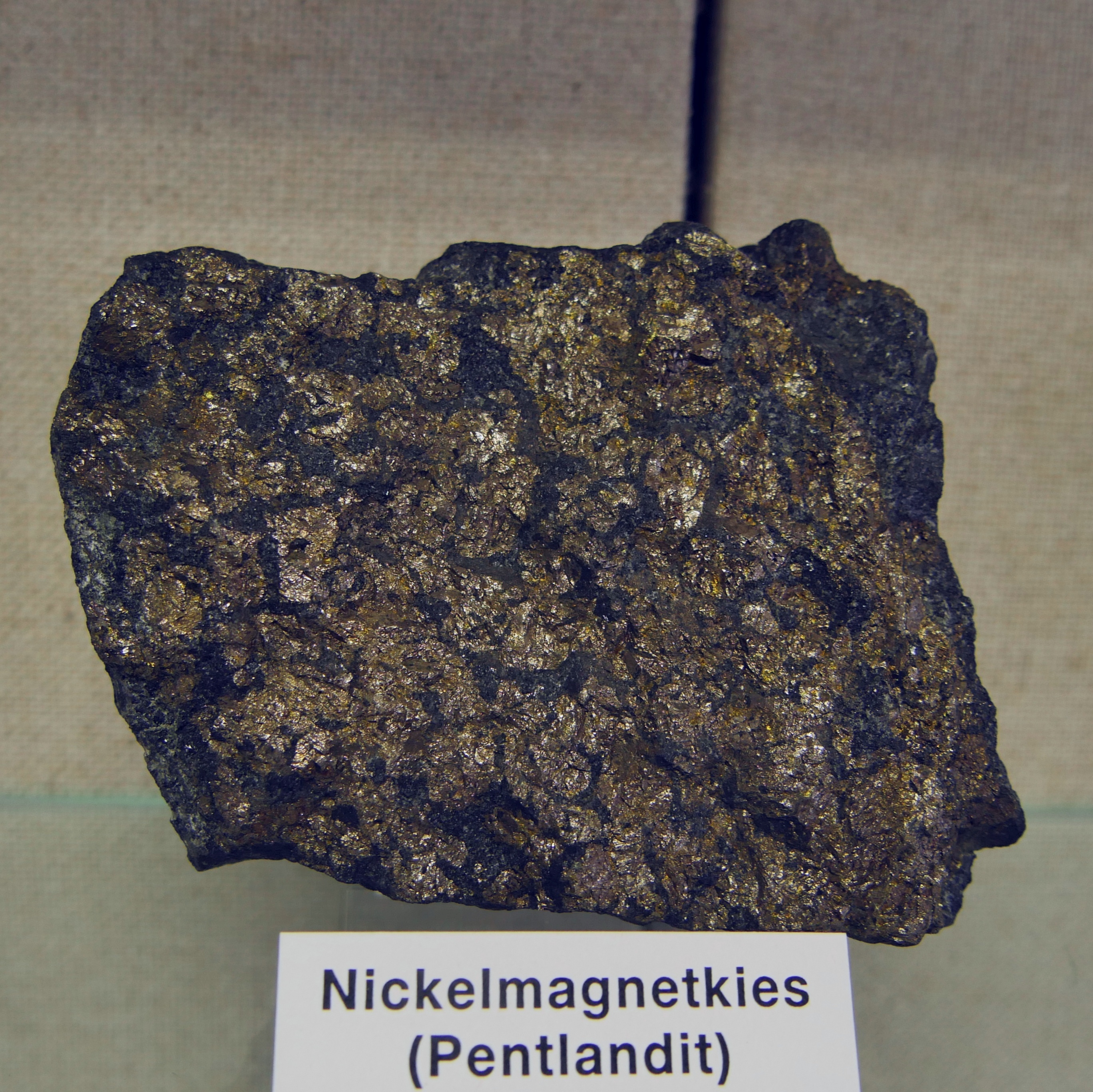
Pentlandite Gemstone: Properties, Meanings, Value & More
Pentlandite is an individual mineral and a group of minerals with similar characteristics. It’s known for being the most common nickel sulfide on Earth, but it’s also a space stone, having been found in dozens of meteorites, a comet, an asteroid, and even on the moon!
Is pentlandite rare? All the minerals in the pentlandite group are somewhat rare. Pentlandite is rarely found in crystal form, and pentlandite gemstones are quite rare.
With a metallic, brassy-yellow hue, pentlandite’s color resembles pyrite. In fact, it was thought to be a pyrite variety when first discovered. So, what is the difference between pyrite and pentlandite?
They’re often found together, but pyrite lacks pentlandite’s obvious parting, doesn’t tarnish as easily as pentlandite, and has a brownish-black streak instead of a grayish-black streak like pentlandite.
Today, we’ll cover all of pentlandite’s mineral data and varieties, along with its prices, history, gemstone forms and more!
 Image credit: John Sobolewski, CC-BY-SA-3.0
Image credit: John Sobolewski, CC-BY-SA-3.0
About Pentlandite Stone
Pentlandite is a rare semi-precious gemstone with the monikers:
Folgerite
Horbachite
Lillhammerite / Lillehammerite
Nicopyrite
“Folgerite” honors US Navy Commodore William M. Folger for his innovative ideas for obtaining nickel-steel for military use.
“Horbachite” was used for partially weathered pentlandite first found in Horbach, Germany. “Lillhammerite” or “Lillehammerite” derives from pentlandite found in the Lillehammer mine in Norway.
“Nicopyrite” likely comes from the early (incorrect) theory that pentlandite was a pyrite variety.
Industrially, what is pentlandite used for?
Pentlandite Uses
Pentlandite is more important industrially than as a gem, but what is the importance of pentlandite?
FIrst and foremost, pentlandite ore is the principal source of nickel. It’s usually mined with pyrrhotite, another source of nickel.
The main uses of nickel today are:
Alloys (e.g. stainless steel) — increases corrosion- and heat-resistance
Coins (e.g. all US coins besides the penny, including the nickel, of course)
Rechargeable batteries — used in laptops, electric vehicles, and power tools
Plating (e.g. faucets and car parts) — attractive finish and increased corrosion-resistance
Additionally, pentlandite has been studied as a raw material (specifically slag containing iron from pentlandite and chalcopyrite) for carbon steel making. Scientists have also investigated heap leaching (an ore extraction process using chemical reactions) of pyrrhotite-rich pentlandite, finding that the pyrrhotite must be dissolved first.
Natural and synthetic pentlandite rocks were studied in 2016 as sustainable electrocatalysts for generating hydrogen.
 Image credit: John Sobolewski (JSS)
Image credit: John Sobolewski (JSS)
Pentlandite Specifications & Characteristics
As an iron nickel sulfide, pentlandite’s formula is (Fe,Ni)9S8 or (Ni,Fe)9S8. The iron-nickel ratio is usually given as 1:1, but some pentlandites are nickel-dominant while others are iron-dominant. Pyrrhotite inclusions can also affect the ratio. Other common impurities include cobalt, silver, or copper.
The pentlandite group encompasses minerals with similar compositions and structures to pentlandite. The group members include:
Argentopentlandite (silver iron nickel sulfide)
Cobalt pentlandite (cobalt sulfide, often minor nickel and iron replacement)
Geffroyite (silver, copper, iron selenium sulfide)
Shadlunite (lead cadmium copper iron sulfide, often with manganese)
Oberthürite (rhodium nickel sulfide)
Sugakite (copper iron nickel sulfide)
All are isometric except the tetragonal sugakite. Cobalt pentlandite and pentlandite form a series.
Most pentlandite specimens are massive to granular aggregates, and pentlandite also frequently occurs as small granular inclusions with thin vein or “flame” shapes. Pentlandite crystals are hexoctahedral but extremely rare.
Is pentlandite magnetic? It only becomes magnetic when heated.
How Do You Identify Pentlandite?
At first glance, pentlandite is easily mistaken for other sulfide minerals with similar brassy yellow coloring and metallic luster.
Minerals commonly confused with pentlandite include pyrite, pyrrhotite, chalcopyrite, and millerite. Some of the distinguishing properties include:
Color: Pentlandite’s color is usually paler than all of these.
Magnetism: Chalcopyrite and pyrrhotite are magnetic. Pyrite is very weakly magnetic and millerite is only magnetic when heated (like pentlandite.)
Streak: The streak colors all somewhat differ: chalcopyrite and millerite are greenish-black, pyrite is brownish-black, pyrrhotite is dark gray to black. However, pentlandite’s streak may be pale bronze-brown or greenish-black.
All that in mind, you may need chemical or optical analysis for proper identification.
Pentlandite properties listed:
Mohs hardness: 3.5-4
Color: Pale bronze-yellow; Sometimes bronze or brown; Reddish-brown when silver-bearing
Crystal structure: Isometric (cubic)
Luster: Metallic
Transparency: Opaque
Refractive index: None
Density: 4.6-5.0
Cleavage: None; Octahedral parting on {111}
Fracture: Conchoidal
Streak: Pale bronze-brown or greenish-black
Luminescence: None
Pleochroism: None
Birefringence: None
Dispersion: None
Types of Pentlandite
Besides argentopentlandite and cobalt pentlandite, there are a few other pentlandite varieties based on impurities:
Palladium-bearing Pentlandite: Usually contains up to 0.17 percent palladium, but the highest had 11.26 percent palladium
Rhodian-bearing Pentlandite: Contains rhodium
Let’s move to pentlandite’s past!
 Image credit: Photo: Reinhard Kraasch, License: CC-BY-SA 4.0 DE
Image credit: Photo: Reinhard Kraasch, License: CC-BY-SA 4.0 DE
Pentlandite History
The first official recorded discovery of pentlandite occurred in the city of Sudbury in Ontario, Canada. Irish scientist, geographer, and traveler Joseph Barclay Pentland made the discovery, likely sometime in the early 1800s. Pentland was also a diplomat and paleontologist.
However, pentlandite wasn’t the first name and Sudbury (or anywhere in Canada for that matter) isn’t the mineral’s type locality. In fact, pentlandite has two type localities and neither are Canada. (Note: Pentland may be honored with the mineral’s name because he was the first to separate nickel from the mineral.)
Type Localities
The first type locality is the Espedalen mines in Innlandet, Norway. Around 1843, German-Norwegian chemist, mineralogist, and metallurgist Theodor Scheerer found a new “iron-nickel pyrite” in this area that contained up to 22 percent nickel. He called it Eisen-Nickelkies, German for “iron-nickel gravel.”
The second type locality is Craignure mine in Scotland, UK. French geologist and mineralogist Pierre-Armand Petit-Dufrénoy (referenced as Dufrénoy A.) published pentlandite from this source in 1856. Dufrénoy thought it was a variety of pyrite and named the stone after Pentland.
Another name for the mineral was “Lillehammerite,” given by German mineralogist Julius Albin Weisbach in 1875 after finding the mineral in Norway’s Lillehammer mine. Another Norwegian source in Lilleålegden, Nordland, was described by Norwegian geologist Johan Herman Lie Vogt in 1892.
IMA Considerations
It should be noted that the International Mineralogical Association (IMA) recognizes the UK (from Dufrénoy’s 1856 description) as the first country where pentlandite was discovered.
Dufrénoy, however, noted in his description: “This variety of pyrite, which yields a new ore of nickel, was dedicated to the learned Mr. Pentland.” Pentland also submitted many of the samples that were analyzed for later descriptions like Dufrénoy’s.
According to the IMA, cobaltpentlandite (originally called “cobalt pentlandite”) was first officially discovered in Finland in 1959, and argentopentlandite’s first discovery was in Russia in 1970.
 Pictured above: Rich ore sample containing a mixture of pentlandite, chalcopyrite, and pyrrhotite. Self-collected by curator Sam Gordon, in 1932. Ex. Philadelphia Academy of Sciences Collection | Image credit: Rob Lavinsky, iRocks.com – CC-BY-SA-3.0
Pictured above: Rich ore sample containing a mixture of pentlandite, chalcopyrite, and pyrrhotite. Self-collected by curator Sam Gordon, in 1932. Ex. Philadelphia Academy of Sciences Collection | Image credit: Rob Lavinsky, iRocks.com – CC-BY-SA-3.0
Pentlandite Healing Properties
As a bronze-yellow healing stone, pentlandite has the confidence- and creativity-boosting properties of yellow gemstones. It’s also a solar plexus chakra stone.
Pentlandite is believed to facilitate higher spiritual awareness, growth, and connection.
Pentlandite Gemstone Properties
Pentlandite gemstones are extremely rare, so standard grading isn’t common, but we’ll go over how the typical value factors apply to pentlandite:
Color: The characteristic pale bronze-yellow, without darkening from alteration, is best.
Cut: Pentlandite isn’t faceted, but it can become cabochons. Most pentlandite for sale is rough (uncut).
Clarity: Since pentlandite is opaque, inclusions don’t matter much. It’s found as an inclusion in many stones, including some Ghana diamonds, emeralds, and Vatomandry rubies.
Carat Weight: Massive pentlandite material can become almost any size cabochon.
Some pentlandites intermixed with chalcopyrite and pyrrhotite have attractive, multicolored looks, great for collector’s specimens.
Onto pentlandite’s formation and locations!
 Pictured above: Microinclusions of sobolevskite and insizwaite in a matrix of subanite-pentlandite-chalcopyrite in a polished specimen | Image credit: David Hospital, CC-BY-SA-4.0
Pictured above: Microinclusions of sobolevskite and insizwaite in a matrix of subanite-pentlandite-chalcopyrite in a polished specimen | Image credit: David Hospital, CC-BY-SA-4.0
Pentlandite Formation & Sources
Usually, pentlandite forms when sulfide melts (formed from evolved silicate melts) cool. It will transform into violarite at 70°C in a few weeks or at 120°C in a few days.
Most pentlandites are found in ultramafic rocks. It’s also found in mantle xenoliths, “black smoker” hydrothermal vents underwater, and meteorites.
Besides the most common pyrrhotite, other common associates are:
Bravoite
Chalcopyrite
Cubanite
Millerite
Valleriite
Chromite
Ilmenite
Magnetite
Sperrylite
Troilite
Mackinawite
Altaite
Galena
Marcasite
Mining Locations
Where is pentlandite most commonly found? The top sources for pentlandite are:
Australia
Canada
Norway
Russia
South Africa
USA (Alaska, California, Nevada)
Most meteorites containing pentlandite have been found in Antarctica, Australia, and the USA.
 Image credit: Andrew Silver, Public domain
Image credit: Andrew Silver, Public domain
Pentlandite Price & Value
Most of the pentlandite mined is used as ore, but some specimens are valuable to collectors.
Pentlandite cabochons are often mixed with minerals like pyrrhotite and braggite. These cabochons are around $100-$150, or about $1-$4 per carat.
The best specimens are $150 to $450 each.
Pentlandite Care and Maintenance
Starting with your safety, pentlandite’s high nickel content makes it potentially toxic. Usually, it will only cause a skin rash in those allergic to nickel, but lapidarists should be careful about inhaling pentlandite dust for long periods of time.
For gemstone care, clean pentlandite with warm water, mild soap, and a soft microfiber cloth. Keep it away from other gems, as pentlandite’s low hardness makes it prone to scratches.
Pentlandite: An Important Stone with Plenty of Uses!
Although pentlandite is mostly used industrially, you can find beautiful pentlandite specimens, especially when it mixes with other minerals to create a metallic, lustrous display!
Search the Gemstone Encyclopedia
Related Auctions
Related Articles
Originally the Birthstones or gemstones were associated with a zodiac sign or the month of a individuals birth. Find out what your stone is and view the stones we have for sale
8th Feb 2021
There are dozens of quartz and chalcedony gems with various colors and patterns. Learn all about quartz properties and every type of quartz, from amethyst and agate to plasma and phantom quartz!
15th Oct 2020
Hackmanite is a pink to violet sodalite gem known for its unique color-change and luminescence. Learn why hackmanite is special, from its rare qualities to the types of hackmanite jewelry available.
28th Mar 2018
Latest Articles
Stibiotantalite is a rare tantalum mineral sometimes found as stunning yellow to orange gems. Discover the history, properties, prices, and uses of stibiotantalite gemstones in this complete guide.
21st Jan 2025
Milarite is a white, green, or yellow beryllium silicate in the milarite-osumilite group. Faceted gems are rare but stunning. Discover the history, properties, prices, and benefits of milarite gems!
6th Jan 2025
Friedelite is an uncommon pink, red, or brown manganese silicate mineral best known from New Jersey and South Africa. Learn the prices, properties, uses, and history of friedelite gemstones.
23rd Dec 2024
Article Categories
How To's is where you will find helpful articles from gem Rock Auctions on how to cut gemstones, select gemstones and buy gemstones.
9 Articles




